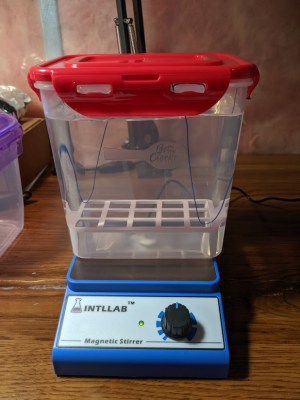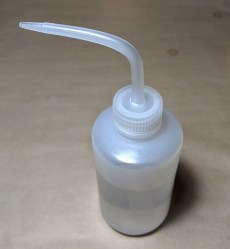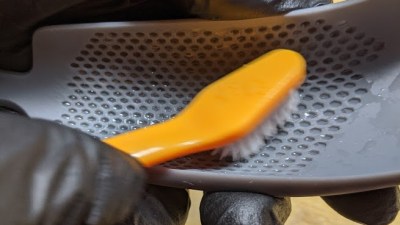After going through all the trouble of printing a part in resin, discovering it feels sticky or tacky to the touch is pretty unwelcome. Giving the model some extra ultraviolet (UV) curing seems like it should fix the problem, but it probably does not. So, what can be done?
The best thing to do with a sticky print is to immediately re-wash it in clean isopropyl alcohol (IPA) before the UV present in ambient light cures stray resin. If the part remains sticky after it is dry, more aggressive steps can be taken.
We’ll get into those more extreme procedures shortly, but first let’s understand a bit more about how resin works, then look at how that applies to preventing and removing tacky surfaces on finished prints.
How Resin Cures, and the Need to Wash
The resin used in stereolithography (SLA) is a syrupy liquid that is UV-cured, meaning it hardens when exposed to the right wavelength of light. But this process is not a perfectly binary one where all exposed resin becomes completely solid, while unexposed resin remains equally and totally liquid. It happens in degrees, and taking advantage of this is indeed part of how SLA printers operate.
 In the SLA process, objects are created one slice at a time, and each slice is a thin layer of resin selectively exposed to UV so that it becomes hard. But this curing process is not always driven to absolute completion. Some of the resin in a layer remains in what is called a green state, which can be thought of as solid but not fully cured. This gives the next layer something to bond to. Each subsequent layer bonds with the previous one, and the UV hardens not just the current layer, but also further cures previous ones as the UV penetrates into the model.
In the SLA process, objects are created one slice at a time, and each slice is a thin layer of resin selectively exposed to UV so that it becomes hard. But this curing process is not always driven to absolute completion. Some of the resin in a layer remains in what is called a green state, which can be thought of as solid but not fully cured. This gives the next layer something to bond to. Each subsequent layer bonds with the previous one, and the UV hardens not just the current layer, but also further cures previous ones as the UV penetrates into the model.
The result of this process is a solid object with no distinct layers that is also covered in uncured resin from the build tank. This excess resin needs to be rinsed away with a solvent, usually isopropyl alcohol (IPA). Some resins get additional curing time by placing them in a UV cure box (or in a pinch, left in sunlight.)
Ideally this process results in a perfectly clean part, but this is not always the case. Uncured resin progressively contaminates the IPA used to wash parts, and it clings to some spots on a model more than others. Just as with hands, incomplete washing is asking for trouble.
Left-Behind Resin Makes Sticky Prints
If enough uncured (or partly-cured) resin is left behind after part washing, it contaminates a print’s surface and makes it sticky. This happens in one or both of the following ways:
- The IPA used to wash parts is dirty. The more parts are washed in a quantity of IPA, the higher the concentration of resin in the IPA becomes. Parts washed in this IPA get coated with a thin layer of diluted resin. The alcohol evaporates, and the resin is left behind. If the concentration is high enough, the part is sticky. Not all resins are alike, and Formlabs uses their own proprietary resins, but according to them, when IPA’s resin concentration reaches 5% to 10%, parts may feel tacky.
- Part washing was incomplete. In general, uncured resin clings more stubbornly to a textured surface. A wash process that reliably rinses resin off a smooth print might not be sufficient to fully remove resin from a print with nooks, crannies, or recessed features.
If the concentration of resin diluted in IPA is too high, the whole part will feel uniformly sticky. If the problem is resin left behind in problem spots, only those areas will feel sticky.
I’ll discuss prevention of sticky prints first, then explain how to salvage a stubbornly-sticky print.
Stopping Sticky Prints in the First Place
The following will help minimize the risk of leaving uncured or partially-cured resin on a print by helping ensure better part washing, and more efficient use of IPA.
Wash The Part Twice, Using Separate Bins

Instead of using only one container of IPA to wash parts, use two separate ones. One is exclusively for an initial washing. After the initial wash — during which most of the resin will be rinsed off — transfer the print directly to the second bin for a final cleaning. The IPA in the second bin will stay cleaner for longer, and do a better job of getting the part clean.
This process also uses less IPA in the long run, compared to a single wash bin of IPA that must be changed out whenever the resin concentration gets too high. With two bins, the primary wash IPA does get dirtier faster, but even “dirty” IPA can do a good job of removing the bulk of uncured resin from a fresh print. The IPA in the second bin, reserved only for finishing, also lasts longer because it has less resin to deal with. When the time comes to refresh the alcohol, use the IPA from the secondary bin as the new primary wash.
Simple containers with lids that can be sealed make good wash bins. Agitation of the IPA, either by shaking the container gently or by stirring, makes washing much more effective.
Target Problem Parts For Extra Washing

Some part geometries are simply harder to get clean. Troublesome features include:
- Pockets, recesses, or textured areas. IPA will flow poorly in and around such features, and uncured resin will tend to stick.
- Tubes, holes or similar internal features where IPA flow is restricted.
- Areas of very dense supports can prevent easy flow of IPA to parts of the model.
Parts can get some extra washing by:
- Allowing more wash time than usual.
- Agitating the wash. Automatic part washers stir the IPA to accomplish this.
- Rinsing with a wash bottle filled with clean IPA.
Different resins have different properties as well: some are easier and some are harder to rinse away. A process that works for some parts and resins may not be sufficient for others.
It may be tempting to give parts a very generous amount of time to soak to ensure a better rinse, but this can invite other problems if carried too far. As prints soak in IPA, they absorb the alcohol and will begin to swell. Over-soaking a part may result in a poor surface finish, or damage fine features.
Compensate for Dirty IPA with Longer Wash Times
In general, the “dirtier” the IPA is, the longer the part should be washed to compensate. But this only works to a certain extent; if IPA contains a high enough concentration of diluted resin, parts will always come out sticky. When this happens, it’s time for fresh IPA. In the meantime, giving a part a final rinse in clean IPA will do the trick, even if it’s just from a wash bottle.
Keep a Wash Bottle Handy
If you don’t own one, you should. They can be used with one hand and are great for getting IPA into specific places, and in controlled amounts.
Fixing a Stubbornly Sticky Print

If prevention has failed, it may be tempting to banish the model to a UV cure box (or leave it out in sunlight) for extra UV exposure in an effort to harden the sticky layer on the surface. In my experience, doing this has never given a satisfactory result. What has reliably worked for me is the following process:
- If possible, re-wash a sticky part immediately in clean IPA before any residual resin cures in ambient light. Allow the print to dry, and see if the problem is solved.
- If the part is still sticky, rinse again with clean IPA and brush with a soft and maneuverable brush such as a toothbrush. This will scrub away any stubborn, partially-cured resin clinging to the surface. Focus on problem areas, and rinse both the brush and the part frequently.
- Give a final rinse in clean IPA, and allow the part to dry. If it remains tacky, repeat the brushing process.
What Else Works?
Ultrasonic cleaning using a clean IPA bath is another possible method of getting into the nooks and crannies of a print, and may be useful for delicate parts that cannot tolerate a brush, but I haven’t personally had to resort to this. What has worked for you? Any tools or methods that have been particularly helpful? Share your favorite techniques in the comments.
No comments:
Post a Comment